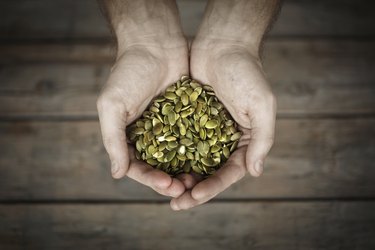Pumpkins (Cucurbita pepo) are annual vining plants that love hot, sunny days. There are over a hundred varieties, ranging from traditional orange to white, pink and almost red. Pumpkins may be round, flattened or pear-shaped; they range in size too, from 'Small Sugar' pumpkins that average 6 to 8 inches in diameter and 5 to 8 pounds to the 'Atlantic Giant' that grows to several feet across, potentially weighing more than 1,000 pounds. In general, smaller pumpkins have a shorter growing season, and the largest pumpkins take longer to mature.

Video of the Day
Ideal Location for Growing Pumpkins
Pumpkins grow best when direct seeded, and they prefer full sun and well drained soil with a pH of 7.0. Work decomposed manure or compost into the soil the fall before spring planting. Spread 2 inches of compost or manure over the soil and work it in to a depth of 6 to 8 inches. Pumpkins are a vining plant and will sprawl almost anywhere you let them.
Video of the Day
Pumpkin Plant Varieties
Pumpkins grow best when seeded directly into the garden. You can start seeds indoors, but pumpkins do not transplant well because their roots are sensitive to disturbance.
Depending on the variety, pumpkins require anywhere from 85 to 130 days to grow from seed. Choose a variety that will grow to full maturity within your growing season. In areas with short growing seasons, good choices may be the heirloom 'Lakota,' which matures at 5 to 7 pounds in 85 to 100 days, or 'Sugar Pie,' which matures at 7 pounds in 100 days. If you have a longer growing season, you could try growing 'Howden,' the commercial Halloween pumpkin, which grows to at least 20 pounds and requires 115 days.
Growing Pumpkins in the Garden
Sow pumpkin seeds when the soil has warmed to 60 degrees Fahrenheit and all danger of frost has passed. Form hills by mounding the soil into soft mounds about 8 to 10 inches high and 1 foot in diameter. Space the hills 4 to 8 feet apart. Before planting, add 1 to 2 tablespoons of 4-8-5 or 6-10-10 fertilizer to each hill. Plant seeds 1 inch deep, placing four to six seeds in each hill. Water well. Pumpkin seeds germinate within four to six days.
When seedlings have two or three true leaves, remove all but the healthiest two or three plants from each hill. When thinning, also choose the seedlings you remove to leave evenly spaced plants. Reapply fertilizer three weeks after planting.
Pumpkin Plant Needs
Water slowly, allowing the water to reach a depth of 6 to 8 inches. Apply about 1 inch of water per week, considering natural precipitation and drying winds. In hot weather, the leaves may appear wilted in the afternoon -- but if the plants are wilted early in the morning, they need more water.
Pumpkins produce male and female flowers on the same plant. The male pumpkin flower will usually appear first, and are attached to a straight stem. A female pumpkin flower has a rounded base, the ovary, which looks like a small fruit.
Insects, especially bees, naturally pollinate pumpkins by flying from flower to flower. If insects do not provide sufficient pollination, you may have to manually pollinate the female flowers. Late in the season, pluck new blossoms to direct the plant's energy to the ripening fruit. Pumpkin flowers, like all squash blossoms, are edible.
Ripening and Harvest
Pumpkins tolerate light frost and can remain in the garden even after frost has killed the vines and foliage. They are ready to harvest when the rind is hard and they have developed a deep, uniform color -- usually orange, but possibly white, green or cream-colored depending on the variety you have grown. Harvest all pumpkins before temperatures drop lower than 25 degrees F.
To harvest, cut the pumpkins off the vine, leaving several inches of stem attached to each fruit. Handle them carefully and do not carry by the stem because it may break off, leaving an opening for disease or pests to enter. Cure pumpkins for 10 days, ideally at 80 to 85 degrees F and 80 percent relative humidity. After curing, store in a cool, dry place at 50 to 55 degrees F with good air circulation around the fruits. Properly stored, pumpkins will keep for at least a few months.
- Purdue University Cooperative Extension Service: Growing Cucumbers, Melons, Squash, Pumpkins and Gourds
- Colorado State University Extension: Cucumbers, Pumpkins, Squash and Melons
- Lancaster County Extension: Get the Most from Your Tomatoes & Pumpkins
- The Old Farmer’s Almanac: Pumpkins
- Seasonal Chef: What to Do with Squash Blossoms